
|
You entered: active region
 The Center of Centaurus A
The Center of Centaurus A
7.11.2010
A fantastic jumble of young blue star clusters, gigantic glowing gas clouds, and imposing dark dust lanes surrounds the central region of the active galaxy Centaurus A. This mosaic of Hubble Space Telescope images taken in blue, green, and red light has been processed to present a natural color picture of this cosmic maelstrom.
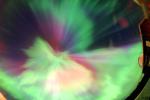 A Full Sky Multi Colored Auroral Corona
A Full Sky Multi Colored Auroral Corona
9.11.2004
On some nights the sky is the most interesting show in town. This fisheye picture captures a particularly active and colorful auroral corona that occurred two days ago over l'Observatoire de la Decouverte in Val Belair near Quebec, Canada.
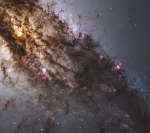 Across the Center of Centaurus A
Across the Center of Centaurus A
29.11.2011
A fantastic jumble of young blue star clusters, gigantic glowing gas clouds, and imposing dark dust lanes surrounds the central region of the active galaxy Centaurus A. This image from the Hubble Space Telescope has been processed to present a natural color picture of this cosmic maelstrom.
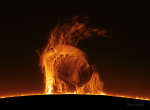 APOD: 2023 August 1 Б Monster Solar Prominence
APOD: 2023 August 1 Б Monster Solar Prominence
1.08.2023
The monsters that live on the Sun are not like us. They are larger than the Earth and made of gas hotter than in any teapot. They have no eyes, but at times, many tentacles. They float. Usually, they slowly change shape and just fade back onto the Sun over about a month.
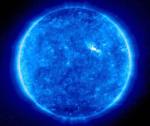 Blue Sun Glaring
Blue Sun Glaring
6.01.1997
The Sun is a bubbling ball of extremely hot gas. In this false-color picture, light blue regions are extremely hot - over 1 million degrees, while dark blue regions are slightly cooler. The camera filter used was highly sensitive to the emission of highly charged iron ions, which trace the magnetic field of the Sun.
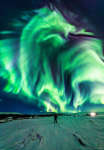 APOD: 2024 January 14 Б Dragon Aurora over Iceland
APOD: 2024 January 14 Б Dragon Aurora over Iceland
14.01.2024
Have you ever seen a dragon in the sky? Although real flying dragons don't exist, a huge dragon-shaped aurora developed in the sky over Iceland in 2019. The aurora was caused...
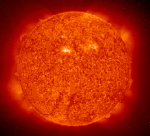 A Winter Solstice
A Winter Solstice
21.12.1997
Today is the Winter Solstice, the shortest day of the year in the Northern Hemisphere. The yearly cycle of Seasons on planet Earth once again finds the Sun at its lowest point in the Northern Sky.
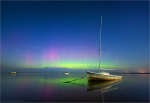 Calm Waters and Geomagnetic Storm
Calm Waters and Geomagnetic Storm
9.09.2017
Very recognizable stars of the northern sky are a backdrop for calm waters in this moonlit sea and skyscape off Cape Cod, Massachusetts. Taken on September 7, the photo also records a colorful display of northern lights or aurora borealis triggered by a severe geomagnetic storm.
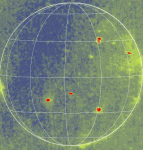 Io's Active Volcanoes
Io's Active Volcanoes
27.10.1996
Why is Io green at night? In this just-released nighttime picture of Jupiter's moon Io, the red spots clearly show Io's current volcanically active regions. But what is causing the global green sheen? This telling picture was taken by the automated Galileo spacecraft currently orbiting Jupiter while Io was in Jupiter's shadow.
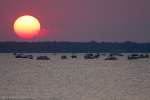 Sunspot at Sunset
Sunspot at Sunset
13.07.2013
Reddened rays of the setting Sun flooded the skies over Cedar Creek Lake, southeast of Dallas, Texas, planet Earth on July 6th. And while sunsets may be the most watched celestial event, this one even offered something extra.
|
January February March April |
|||||||||||||||||||||||||||||||||||||||||||||||||